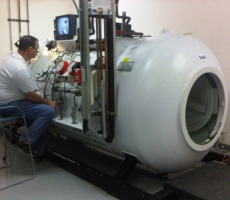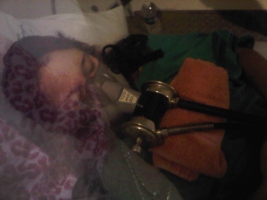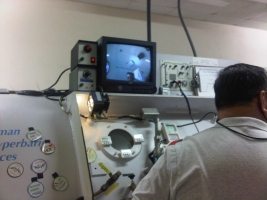Hyperbaric chamber looks to add volunteers
 (CNS): Hoping to add to his team of volunteers, John Elliott, Director of Cayman Hyperbaric Services, is planning a training course this fall to teach up to 12 people how to monitor the equipment that treats divers suffering from the bends. Working right now with a dedicated corps of 30 volunteers who can be called in at all hours to operate the hyperbaric chamber at the Cayman Islands Hospital (with six technicians operating the facility on Cayman Brac), Elliott says that, at times, the pool of available staff can be low.
(CNS): Hoping to add to his team of volunteers, John Elliott, Director of Cayman Hyperbaric Services, is planning a training course this fall to teach up to 12 people how to monitor the equipment that treats divers suffering from the bends. Working right now with a dedicated corps of 30 volunteers who can be called in at all hours to operate the hyperbaric chamber at the Cayman Islands Hospital (with six technicians operating the facility on Cayman Brac), Elliott says that, at times, the pool of available staff can be low.
Holidays, work hours and sickness can deplete the full complement of technicians, and at least three people are needed at any one time to monitor the equipment from the outside and sit with the patient in the chamber.
The close-knit group, however,is always ready to answer the call, and recently dealt with two cases of people suffering from decompression sickness, one a tourist off a cruise ship and the other, 17-year-old Caymanian Elizabeth Schvartz.
After a morning dive on Saturday, 9 July, Schvartz felt unwell, complaining of a headache, and chest and back pain. When the symptoms didn’t subside by evening, her parents took her to the Accident & Emergency Unit at the hospital where the doctor decided she needed to go into the chamber.
 At about 1:30am, Dr Denise Osterloh, one of three physicians on-island trained to deal with decompression illness, was called. In less than an hour, the volunteer team was being assembled. “We always manage but sometimes it is a struggle to get people. We can always do with more volunteers,” she said, while praising the current members of the team, who only receive a small stipend per contact hour for the work they do.
At about 1:30am, Dr Denise Osterloh, one of three physicians on-island trained to deal with decompression illness, was called. In less than an hour, the volunteer team was being assembled. “We always manage but sometimes it is a struggle to get people. We can always do with more volunteers,” she said, while praising the current members of the team, who only receive a small stipend per contact hour for the work they do.
“I think they do a fabulous job and everyone always speaks highly of them. They are a great bunch of people. They keep patients occupied who are in a highly anxious, nervous state in a small environment. They are available any hour of the day. They are a very valuable part because without them, no matter what we know, we can’t do the treatment.”
Schvartz’s parents watched the technicians in action through the night. “As her parents, we were amazed at these people,” said mom, Mia Schvartz. “Nobody made us feel it was an inconvenience for them to come out at 4, 5, 6 in the morning. It was just: ‘We’re here. How can we help?’”
Each technician can only sit inside the chamber for about an hour, requiring a rota of volunteers to come in during the average five hours it takes for a patient to recompress. With so many technicians needed for each session, it can be a challenge to organize a crew from the 30 volunteers available, hence the plan for another training course.
 But the ones that continue to help make a big impression. “They have full-time jobs yet they will crawl out of their beds or come during their lunch hour to help,” Schvartz said. “I don’t feel like there were enough thank yous I could say. As parents, we couldn’t do anything but watch them take care of our daughter.” Marcel Archer, who has been volunteering since 1982, was one of the technicians who answered the call that evening. “I’ve been a volunteer so long it is probably part of my DNA by now,” he said.
But the ones that continue to help make a big impression. “They have full-time jobs yet they will crawl out of their beds or come during their lunch hour to help,” Schvartz said. “I don’t feel like there were enough thank yous I could say. As parents, we couldn’t do anything but watch them take care of our daughter.” Marcel Archer, who has been volunteering since 1982, was one of the technicians who answered the call that evening. “I’ve been a volunteer so long it is probably part of my DNA by now,” he said.
Archer, a trained paramedic and nurse, spent an hour in the chamber with Elizabeth. He said his approach with patients is to “uplift their spirits, keep them distracted, and keep them alert and calm as possible so they do not feel claustrophobic or frightened or tense.”
He also noted that the team could use more people. “It’s one of those services that is essential but from a medical standpoint, there are very few who are trained to do it. Due to the small number of volunteers, it is difficult to respond. We get a small window of opportunity to commence treatment. The longer it takes for treatment to start, the worse the prognosis.”
Elliott, together with his wife, Ann, has been running Cayman Hyperbaric Services since 1996, taking over from the British Sub-Aqua Club, but both have at least 25 years experience in operating the decompression chamber.
Though not as busy as it was a few decades ago, an average of 40 to 45 patients every year come to them with decompression sickness. But when the call goes out, there needs to be enough technicians ready to come in.
“Every one of us are divers and first of all, we do it because it is in our blood. No one gets involved for the finance of it,” John Elliott said.
“We look at the team as a big family.”
Cayman Hyperbaric Services can be contacted by email by diveraid@candw.ky or by telephone at 949-8600 extension 2579 or 949-2989.
Category: Health


What does “looks to ” mean?
Is there some contact info? email or phone?
CNS: I've added this to the bottom of the article.
I'd do it, but I'm afraid there's too much pressure.